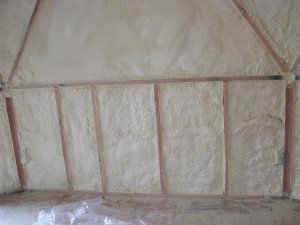Sprayed-Foam Insulation
Sprayed-Foam and Foamed-In-Place Insulation Introduction
Today, some foam insulation consists of materials similar to those found in pillows and mattresses. Also, foam materials now use foaming agents that don’t use chlorofluorocarbons (CFC’s) or hydrochlorofluorocarbons (HCFC’s), which are harmful to the Earth’s ozone layer.
Some types of available liquid foam insulation materials include these:
- Cementitious
- Phenolic
- Polyisocyanurate
- Polyurethane
Some other types include Icynene foam and Tripolymer foam. Icynene foam can be either sprayed or injected, which makes it the most versatile. It also has good resistance to both air and water intrusion. Tripolymer foam—a water-soluble foam—is injected into wall cavities. It has excellent resistance to fire and air intrusion.

Urea-formaldehyde (UF) foam was used in homes during the 1970s and early 1980s. It is no longer available for residential use because of health-related risk with formaldehyde. All new types of foam insulation do not use formaldehyde.
Installation

Liquid foam insulation—combined with a foaming agent—can be applied using small spray containers or in larger quantities as a pressure-sprayed (foamed-in-place) product. Both types expand and harden as the mixture cures. They also conform to the shape of the cavity, filling and sealing it thoroughly.
Installation of most types of liquid foam insulation in large areas requires special equipment and certification. Therefore, you’ll probably want a certified insulation installer to do it.
Following installation, some foams require a thermal barrier—such as drywall or an intumescent paint. Also, building codes recognize sprayed closed cell foam insulation as a vapor barrier, so you do not need an additional air barrier, like polyethylene or some other vapor retarder.
Costs

Liquid foam insulation products and installation cost more than traditional batt insulation. However, liquid foam insulation also forms an air barrier. This can help eliminate some of the other costs and tasks associated with weatherizing a home, such as caulking, applying housewrap and vapor barrier, and taping joints. When building a new home, this type of insulation can also help reduce construction time and the number of specialized contractors, which saves money.
Sprayed Urethane Foam
All closed-cell polyurethane foam insulation made today is produced with a non-CFC (chlorofluorocarbon) gas as the foaming agent. These foams have an aged R-value of R-6.5 per inch thickness. Their density is generally 2.0 lb/ft3 (32.0 kilograms per cubic meter [kg/m3]). There also are low-density open-cell polyurethane foams (0.5 lb/ft3 [8 kg/m3]). These foams are similar to conventional polyurethane foams, but are more flexible. Some low-density varieties use carbon dioxide (CO2) as the foaming agent.
Low-density foams are sprayed into open wall cavities and rapidly expand to seal and fill the cavity.
One manufacturer offers a slow-expanding foam, which is intended for cavities in existing homes. The liquid foam expands very slowly and thus reduces the chance of damaging the wall from over expansion. The foam is water-vapor permeable, remains flexible, and is resistant to wicking of moisture. It provides good air sealing and yields about R-3.6 per inch of thickness. It is also fire resistant and won’t sustain a flame.
Soy-based, polyurethane liquid spray-foam products are also available. The cured R-value is around 3.7 per inch. These products can be applied with the same equipment used for petroleum-based polyurethane foam products.

Rigid Insulation Board
Rigid insulation board will work only if provisions are made for at least 1 1/2” of ventilation space between the outside sheathing and the insulation. Without an air tight seal around all the edges of the rigid foam pieces, you need to deal with ventilation and vapor barriers. Most rigid foam’s R-value is twice that of fiberglass but its cost is two to three times greater
Cellulose, lamb’s wool, natural cotton

These insulation types are some of the other insulation currently available. We can help you figure out what’s best for your dome. We have tried some – some work, some don’t.
